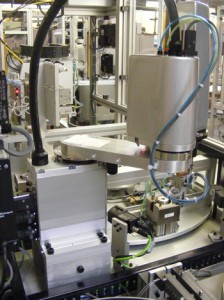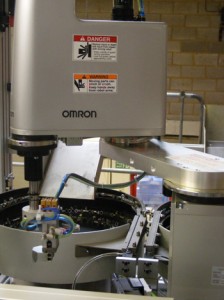Omron SCARA robot assembles spigots cost effectively
 When it needed to automate the assembly of a moulded plastic spigot, a leading Automotive parts manufacturer asked industrial automation expert ALPHR Technology to devise a solution that would be cost effective, compact, reliable and easy to maintain. After carefully analysing the application, the ALPHR Technology team concluded that a solution based on an Omron SCARA robot, used in conjunction with a vision system and other automation products from Omron, would be the best way by far of meeting these requirements.
When it needed to automate the assembly of a moulded plastic spigot, a leading Automotive parts manufacturer asked industrial automation expert ALPHR Technology to devise a solution that would be cost effective, compact, reliable and easy to maintain. After carefully analysing the application, the ALPHR Technology team concluded that a solution based on an Omron SCARA robot, used in conjunction with a vision system and other automation products from Omron, would be the best way by far of meeting these requirements.
A specialist in the design and production of precision injection-moulded parts for the automotive industry, the customer had, for some time, been supplying injection-moulded spigots to a leading automobile manufacturer. In the past, assembly of the spigots had been a largely manual process, but when an increase in demand for the spigots meant the need for an additional production line, the company decided to investigate the possibility of automated assembly.
In essence, the assembly process involves fitting four compression limiters of two different sizes to the spigot. The limiters have to be accurately positioned and pressed into place to a precisely defined depth. Once fitted, they have to be retained with a specified force. The final stage of the process is to carry out a leak test on the completed spigot assembly to verify not only that the limiters have been fitted correctly, but also to check the integrity of the part itself.
After detailed discussions, the team from ALPHR Technology proposed a machine with a PLC-controlled rotary assembly station, which would produce one finished part every 20 seconds. Just one operator would be needed, loading the parts into the machine, with all other operations performed automatically, including inspection, testing and the delivery of the finished parts to pass and fail bins.
ALPHR Technology gave considerable thought to the details of the machine, and ultimately concluded that a machine using conventional multi-axis pick-and-place technology would be complicated to design and build, inflexible, and ultimately difficult to maintain. A solution based on an Omron SCARA robot would, however, solve all of these problems as well as addressing a requirement for the machine to have the smallest possible footprint.
 Further, a careful costing of the machine, taking into account not only the cost of equipment and materials, but also the cost of design and construction, revealed the robotic solution to be significantly more financially attractive. These factors made the robotic solution very interesting but, while the customer is a long-time user of large multi-axis robots, it had no previous experience of SCARA robots. Before making a substantial investment in the new machine, therefore, the company understandably looked for assurance that it would perform as predicted.
Further, a careful costing of the machine, taking into account not only the cost of equipment and materials, but also the cost of design and construction, revealed the robotic solution to be significantly more financially attractive. These factors made the robotic solution very interesting but, while the customer is a long-time user of large multi-axis robots, it had no previous experience of SCARA robots. Before making a substantial investment in the new machine, therefore, the company understandably looked for assurance that it would perform as predicted.
Application engineers from Omron provided this assurance by using sophisticated software to emulate the operation of the proposed assembly machine. This not only confirmed that the principle of operation of the machine was sound, but also that the required cycle times and efficiencies could be easily achieved. With its questions answered and concerns dispelled by this demonstration, the customer gave the go ahead for the project.
As built, the spigot assembly machine works on a part that the operator has manually loaded into one of the “nests” in the machine’s rotary assembly table. A pneumatic cylinder pushes the part fully home and then the table indexes. Next, the robot takes the four compression limiters, one at a time, from vibratory feeders and places them into the part.
Two Omron FQ vision sensors confirm that the limiters are all present and correctly positioned, and then the table indexes again, moving the part to a station where the limiters are inserted with Pneumatic cylinders and then a force push out test is carried out by applying a precisely controlled force.
The table indexes once more to bring the part to the final station where it is pressurised and tested for leakage. Depending on the results of the test, the part is transferred either to the pass bin or the fail bin, the latter being kept behind a locked door within the machine to ensure that defective parts can never be accidentally mixed with good products. Passed and failed parts are automatically counted, and the machine notifies the operator when the bins are ready to be emptied.
“Understandably, as this was the company’s first machine with a SCARA robot, they kept a close eye on this project,” said Paul Bridgwater of ALPHR Technology, “so I’m delighted to say that it went very smoothly. Programming the robot was straightforward and it worked ‘straight out of the box’ as did the vision system, and all of the other key automation components supplied by Omron.”
The new spigot assembly machine has now been working on site for several months, and is fully living up to expectations. While, as planned, the rate of production of the new machine is not substantially different from that of the manual assembly line, the percentage of reject parts is greatly reduced, as the dependable robotic placement of the compression limiters and the 100% inspection by the vision sensor’s make it virtually impossible for incorrectly assembled parts to go forward to the final testing stage.
Visit the Omron website for more information.
See all stories for Omron















